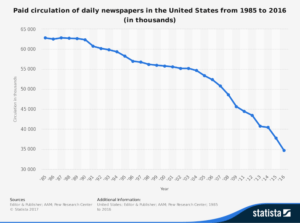Bezos, The Digital Midas. Turning Around the Washington Post

If one person has the knack for turning a digital-phobic industry on its head, it's Jeff Bezos. His acquisition and subsequent digital transformation of the Washington Post has been a massive success. How did Bezos take a struggling paper, in a broadly struggling industry, and turn it into a digital publishing powerhouse?
It’s no secret that newspapers in the United States are a dying industry. Circulation growth has been negative since the 50’s as television and then the internet became the preferred source of news for the average reader. This acceleration has increased in the 2000s as more and better reporting has come online and consumer attention shifts from broad national/global stories published once per day, to a 24-hour news cycle tailored to individual preference. Previous attempts by newspaper companies have not been met with large success, and paywalls have consistently been a difficult hurdle for consumers to get over.
Bezos’ focus appears to be primarily technology focused. Similar to his strategy with Amazon, the back-office functions of the business have been brought to the top of the priority list. Bezos appears to be developing the technological backbone of the Washington Post to be deployed to multiple other papers that are looking to go digital first, similar to how Amazon pioneered the cloud computing model under AWS. Arc Publishing, is effectively a turnkey digital publishing solution, including a full analytics package to supercharge digital subscriber growth through an effective paywall campaign[1]. Bezos has been using the Washington Post as his testbed for developing what the Washington Post predicts could be a $100mm business[2].
Second, Bezos has dramatically increased the number of reporters that are developing digital-first content, effectively making the Post a digital-first paper. According to the Washington Post, they produce roughly 500 stories per day, double that of the New York Times, with a dramatically smaller news team (700 vs 1,300 employees). This volume of digital publishing doubles digital only giants such as Buzzfeed[3], while maintaining a high level of credibility[4] uncommon to digital publishing.
This focus on digital has certainly seen success. In November of 2015, the Washington Post first eclipsed the New York Times in terms of digital views according to ComScore[5]. This gap has continued to widen as the Washington Post has been able to make massive digital view gains month over month, translating to large growth in digital subscriptions as well. From 2015-2016 digital subscriptions grew 145%[6] topping 1 million subscribers in 2017. The Washington Post was able to do this through a comprehensive distribution strategy involving a massive push through Facebook Instant Articles[7], and second through a free 6-month trial subscription through Amazon prime[8].
These changes seem to have been positive for the Post, their back-end digital publishing system is getting traction with key customers such as the Los Angeles Times, Canada’s Globe and Mail, and the New Zealand Herald[9]. The News Room is increasingly seen as a marquee posting[10], and the paper has been profitable for the past two years[11]. Something that could not be said while it was under the control of its former owners, the Graham family. Hopefully, this upward trend can continue, and the newspaper industry can look to the Washington Post as a positive example of how to make digital work while the traditional pulp and ink model continues to decline.
[1] https://www.arcpublishing.com/
[2] http://nymag.com/daily/intelligencer/2016/06/washington-post-jeff-bezos-donald-trump.html
[3] http://www.niemanlab.org/2016/06/a-few-figures-and-facts-about-the-washington-posts-digital-transition-under-jeff-bezos/
[4] https://www-statista-com.ezp-prod1.hul.harvard.edu/statistics/739442/washington-post-credibility-usa/
[5] https://digiday.com/media/comscore-washington-post-tops-new-york-times-online-first-time-ever/
[6] https://digiday.com/media/washington-post-grew-digital-subscriptions-145-percent/
[7] https://digiday.com/media/4-publishers-using-facebook-instant-articles/
[8] https://techcrunch.com/2015/09/16/amazon-prime-members-can-now-get-the-washington-post-for-free-for-6-months/
[9] https://www.fastcompany.com/40495770/the-washington-post-is-a-software-company-now
[10] https://www.politico.com/media/story/2016/12/the-profitable-washington-post-adding-more-than-five-dozen-journalists-004900
[11] https://www.geekwire.com/2018/washington-post-profitable-growing-two-years-jeff-bezos-ownership/




Thanks for the interesting post! It’s surprising to see how much growth the Washington Post has gained just by having a stronger distribution strategy that is leveraging the current trend of more people wanting to read news digitally. Based on their results, it does seem that customers perceive higher value for the convenience than the quality of content (where the Post probably meets a “good enough” bar). However, I’m slightly doubtful that the Post can generate twice the number of articles as New York Times, on a smaller staff, and not dilute the quality of the content.
The turnkey publishing solution also sounds promising, and reminds me of companies we saw in class examples (e.g., Fujifilm, Garmin) that have been quick to establish itself in adjacent/related industries when its core industry was being disrupted.
Thanks for a great post! Very interesting to see a newspaper company thriving as described. Would be curious to learn more about their value capture strategy – in addition to the subscription business, is WashPo making significant money any other way? In particular, are they making ad revenues as well? Was very interesting to learn that they have eclipsed even NYT in terms of online views!